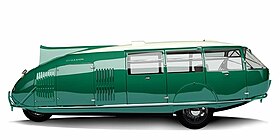
Back Coche Dymaxion AST Dymaxion (automobil) Czech Dymaxion-Auto German Coche Dymaxion Spanish Dymaxion Car HE Dymaxion Car Italian ダイマクション・カー Japanese Dymaxion-auto Dutch Dymaxion Polish Dymaxion Russian
| Dymaxion car | |
|---|---|
 Dymaxion replica | |
| Overview | |
| Manufacturer | The Dymaxion Corporation Bridgeport, Connecticut |
| Also called | 4D Transport |
| Production | 1933 three prototypes built |
| Assembly | Bridgeport, Connecticut |
| Designer | Bucky Fuller with Starling Burgess and Isamu Noguchi |
| Body and chassis | |
| Class | Concept car |
| Body style | Sheet aluminum on ash frame |
| Layout | Rear-engine, front-wheel-drive |
| Platform | Varied per prototype: double or triple hinged, cromoly steel |
| Powertrain | |
| Engine | Ford flathead V8 |
| Transmission | Ford |
| Dimensions | |
| Length | 20 ft (6,096.0 mm) |
With such a vehicle at our disposal, [Fuller] felt that human travel, like that of birds, would no longer be confined to airports, roads, and other bureaucratic boundaries, and that autonomous free-thinking human beings could live and prosper wherever they chose.
Lloyd S. Sieden, Bucky Fuller's Universe, 2000
Fuller described the Dymaxion as a "zoomobile", explaining that it could hop off the road at will, fly about, then, as deftly as a bird, settle back into a place in traffic.
R. (Richard) Buckminster Fuller 1895-1983

The Dymaxion car was designed by American inventor Buckminster Fuller during the Great Depression and featured prominently at Chicago's 1933/1934 World's Fair.[1] Fuller built three experimental prototypes with naval architect Starling Burgess – using donated money as well as a family inheritance[2][3] – to explore not an automobile per se, but the 'ground-taxiing phase' of a vehicle that might one day be designed to fly, land and drive – an "Omni-Medium Transport".[4] Fuller associated the word Dymaxion with much of his work, a portmanteau of the words dynamic, maximum, and tension,[5] to summarize his goal to do more with less.[6]
The Dymaxion's aerodynamic bodywork was designed for increased fuel efficiency and top speed, and its platform featured a lightweight hinged chassis, rear-mounted V8 engine, front-wheel drive (a rare RF layout), and three wheels. With steering via its third wheel at the rear (capable of 90° steering lock), the vehicle could steer itself in a tight circle, often causing a sensation.[7][8] Fuller noted severe limitations in its handling, especially at high speed or in high wind, due to its rear-wheel steering (highly unsuitable for anything but low speeds) and the limited understanding of the effects of lift and turbulence on automobile bodies in that era – allowing only trained staff to drive the car and saying it "was an invention that could not be made available to the general public without considerable improvements."[9] Shortly after its launch, a prototype crashed and killed the Dymaxion's driver.[10][11][12]
Despite courting publicity and the interest of auto manufacturers, Fuller used his inheritance to finish the second and third prototypes,[13] selling all three, dissolving Dymaxion Corporation and reiterating that the Dymaxion was never intended as a commercial venture.[14] One of the three original prototypes survives,[15] and two semi-faithful[16] replicas have recently been constructed. The Dymaxion was included in the 2009 book Fifty Cars That Changed The World[17] and was the subject of the 2012 documentary The Last Dymaxion.
In 2008, The New York Times said Fuller "saw the Dymaxion, as he saw much of the world, as a kind of provisional prototype, a mere sketch, of the glorious, eventual future."[3]
- ^ US 2101057
- ^ Frank Magill (1999). The 20th Century A–GI: Dictionary of World Biography, Volume 7. Routledge. p. 1266. ISBN 1136593349.
- ^ a b Phil Patton (June 2, 2008). "A 3-Wheel Dream That Died at Takeoff". The New York Times.
- ^ Marks, Robert (1973). The Dymaxion World of Buckminster Fuller. Anchor Press / Doubleday. p. 104.
- ^ Sieden, Lloyd Steven (2000). Buckminster Fuller's Universe. Basic Books. p. 132. ISBN 978-0-7382-0379-9.[permanent dead link]
- ^ McHale, John (1962). R. Buckminster Fuller. Prentice-Hall. p. 17.
- ^ Cite error: The named reference
Kleinerwas invoked but never defined (see the help page). - ^ Marks, Robert (1973). The Dymaxion World of Buckminster Fuller. Anchor Press / Doubleday. p. 29.
- ^ Lloyd Steven Sieden (August 11, 2000). Buckminster Fuller's Universe. Basic Books. ISBN 9780738203799.[permanent dead link]
- ^ Cite error: The named reference
:0was invoked but never defined (see the help page). - ^ "Passenger Files: Francis T. Turner, Colonel William Francis Forbes-Sempill and Charles Dollfuss". Stanford University Archives. Archived from the original on August 21, 2012.
- ^ Davey G. Johnson (March 18, 2015). "Maximum Dynamism! Jeff Lane's Fuller Dymaxion Replica Captures Insane Cool of the Originals". Car and Driver. Archived from the original on May 18, 2015. Retrieved April 28, 2015.
- ^ R. Buckminster Fuller (1983). Inventions: The Patented Works of R. Buckminster Fuller. St. Martin's Press.
- ^ "About Fuller, Session 9, Part 15". Bucky Fuller Institute. Archived from the original on 2015-05-18. Retrieved 2015-04-29.
- ^ Allison C. Meier. "Dymaxion Car at the National Automobile Museum in Reno, Nevada. The only surviving prototype". AtlasObscura. Retrieved September 27, 2020.
- ^ Cite error: The named reference
locowas invoked but never defined (see the help page). - ^ Andrew Nahum (2009). Fifty Cars that Changed the World. Conran Octopus. ISBN 9781840915853.
© MMXXIII Rich X Search. We shall prevail. All rights reserved. Rich X Search